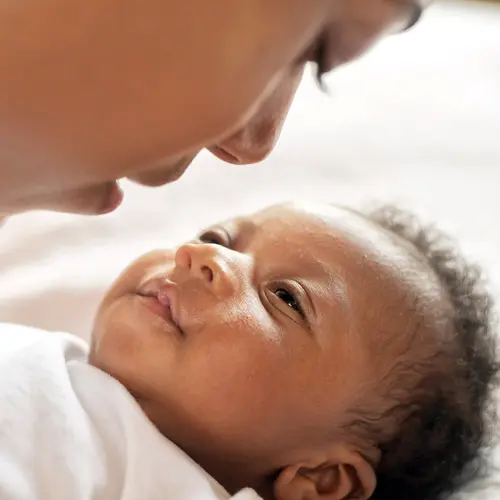Newborns tend to have an irregular breathing pattern that alternates between fast and slow, with occasional pauses. If your baby makes noises when breathing, take note of what they sound like, or make a recording for the next visit with the pediatrician. This will help determine if there is a problem in the breathing passages and where:
- Whistling noise: A small blockage in the nostrils tends to make a whistling noise that clears when you suction it out. Newborn babies breathe out of their noses, not their mouths. This is a good trick, as it allows them to breathe and eat at the same time. However, their little noses have small air passages, so a little bit of mucus or dried milk can make the breathing passage even smaller, causing a whistling noise or occasionally, difficulty moving the air in and out.
- Hoarse cry and a "barking" cough: A blockage in the larynx (windpipe), often due to mucus, makes a hoarse cry and a "barking" cough. This may be a sign of croup, an infection of the larynx, trachea and bronchial tubes. Croup is not a common infection in newborns.
- High-pitched, squeaky sound: Called stridor or laryngomalacia, this is a sound very young babies make when breathing in. It is worse when a child is lying on their back. It is caused by excess tissue around the larynx and is typically harmless. It typically passes by the time a child reaches age 2.
- Deep cough: A blockage in the large bronchi (divisions of the trachea, which lead into the lungs) makes a deep cough.
- Whistling sound (wheezing): A blockage in the bronchioles (small airways that come from the bronchi) makes a whistling sound when the infant breathes out (as in bronchiolitis or asthma later on).
- Fast, labored breathing: Fluid in the smallest airways (the "alveoli") causes pneumonia, an infection due to a virus or bacteria. Pneumonia causes fast, labored breathing, occasionally cyanosis, a persistent cough, and crackly sounds ("rales") when listened to with a stethoscope.
Tips for Concerned Parents:
Watch your baby's breathing when they are well, so you can get used to how it looks. Time how many breaths they take in a minute. It's probably faster than you imagined. Knowing what's normal for your baby's breathing will help you spot a potential problem more quickly.
When in doubt of what's going on, make a video of the breathing pattern that is worrying you to show to your baby's health care provider.
When to Worry About Baby's Breathing
Signs of potentially worrisome breathing problems in your baby include:
- Persistently increased rate of breathing (greater than 60 breaths per minute or so)
- Increased work to breathe. Signs of this include:
- Grunting. The baby makes a little grunting noise at the end of respiration. This serves to try to open up blocked airways.
- Flaring. The baby's nostrils flare during breathing, showing increased effort.
- Retractions. The muscles in the baby's chest (under the ribs) and neck are visibly seen going in and out much more deeply than usual.
- Cyanosis. This means the blood has remained blue and has not gotten sufficient oxygen from the lungs (such as with pneumonia). For true cyanosis, the blood all over the body should look blue. Check areas that get a lot of blood flow, such as the lips and the tongue. Sometimes, the hands and feet of newborns turn bluish, but the rest of the body is fine. This is not cyanosis but a common response to changes in temperature.
- Difficulty feeding. Your baby is unable to sustain a latch on the breast or is refusing to feed.
- Poor feeding. "Respiratory distress" is often accompanied by a noticeable decrease in feeding intake.
- Lethargy. Your baby's energy level may be markedly decreased if they have a significant lung problem.
- Fever. Most infections of the lung will cause a fever, as well. Always check your baby's temperature when you are concerned.
Breathing problems (such as noisy breathing) that only occur occasionally are normal. Worrisome breathing problems, on the other hand, are usually persistent.
However, when it comes to any breathing concerns, be sure to contact your pediatrician.


